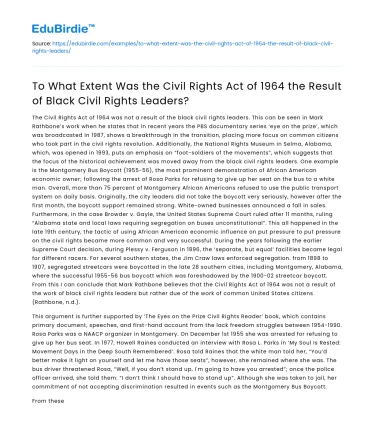The Civil Rights Act of 1964 was not a result of the black civil rights leaders. This can be seen in Mark Rathbone’s work when he states that in recent years the PBS documentary series ‘eye on the prize’, which was broadcasted in 1987, shows a breakthrough in the transition, placing more focus on common citizens who took part in the civil rights revolution. Additionally, the National Rights Museum in Selma, Alabama, which, was opened in 1993, puts an emphasis on “foot-soldiers of the movements”, which suggests that the focus of the historical achievement was moved away from the black civil rights leaders. One example is the Montgomery Bus Boycott (1955-56), the most prominent demonstration of African American economic owner; following the arrest of Rosa Parks for refusing to give up her seat on the bus to a white man. Overall, more than 75 percent of Montgomery African Americans refused to use the public transport system on daily basis. Originally, the city leaders did not take the boycott very seriously, however after the first month, the boycott support remained strong. White-owned businesses announced a fall in sales. Furthermore, in the case Browder v. Gayle, the United States Supreme Court ruled after 11 months, ruling “Alabama state and local laws requiring segregation on buses unconstitutional”. This all happened in the late 19th century, the tactic of using African American economic influence on put pressure to put pressure on the civil rights became more common and very successful. During the years following the earlier Supreme Court decision, during Plessy v. Ferguson in 1896, the ‘separate, but equal’ facilities became legal for different racers. For several southern states, the Jim Craw laws enforced segregation. from 1898 to 1907, segregated streetcars were boycotted in the late 28 southern cities, including Montgomery, Alabama, where the successful 1955-56 bus boycott which was foreshadowed by the 1900-02 streetcar boycott. From this I can conclude that Mark Rathbone believes that the Civil Rights Act of 1964 was not a result of the work of black civil rights leaders but rather due of the work of common United States citizens (Rathbone, n.d.).
This argument is further supported by ‘The Eyes on the Prize Civil Rights Reader’ book, which contains primary document, speeches, and first-hand account from the lack freedom struggles between 1954-1990. Rosa Parks was a NAACP organizer in Montgomery. On December 1st 1955 she was arrested for refusing to give up her bus seat. In 1977, Howell Raines conducted an interview with Rosa L. Parks in ‘My Soul Is Rested: Movement Days in the Deep South Remembered’. Rosa told Raines that the white man told her, “You’d better make it light on yourself and let me have those seats”, however, she remained where she was. The bus driver threatened Rosa, “Well, if you don’t stand up, I'm going to have you arrested”; once the police officer arrived, she told them: “I don’t think I should have to stand up”. Although she was taken to jail, her commitment of not accepting discrimination resulted in events such as the Montgomery Bus Boycott.
Save your time!
We can take care of your essay
- Proper editing and formatting
- Free revision, title page, and bibliography
- Flexible prices and money-back guarantee
From these two sources of information about the Montgomery Bus Boycott and Rosa Parks, I can conclude that is it is very clearly presented that Howell Raines supports the idea of the Civil Rights Act of 1964 not being a result of the work of black civil rights leaders. Raines supports the idea that the act was the work of the common United States citizens (Clayborne Carson, 1991). Overall, this helps me to argue with my report’s question about the extent to which the Civil Rights Act of 1964 was the result of the work of black civil rights leaders, as it contrasts with the main idea. Showing that the Civil Rights Act is not 100 percent a result of the black Civil Rights leaders. To add to this, this also links to the introduction of this report. The minority (Rosa Park) influenced the majority (United States citizens). As a result, people felt more confidant and comfortable to protest against the discrimination of black Americans.






 Stuck on your essay?
Stuck on your essay?

